From the dawn of TV sports in the 1950s through the 1980s, “Hello everybody, I’m Lindsey Nelson” were familiar words for viewers across the nation. In so many ways, Nelson ascended along with his medium. At the 1963 Army–Navy game, he introduced his audience to a technical marvel—the instant replay, though it didn’t get that name until later. When an Army touchdown run was replayed, Nelson, concerned that viewers might be confused when they saw the running back once again cross the goal line, said, “Ladies and gentlemen, Army has not scored again.”
It was when the New York Mets TV broadcasts went from black and white to color in the early 1960s that Nelson, looking to present a colorful image on the screen, adopted his sartorial trademark of garish plaid sports jackets. “I went to a clothing store and said, ‘Let me look at all the coats you were unable to sell this year. The man brought them out. A lot of them. I looked them over and said, ‘Yeah. Yeah. I’ll take them all.’”
At one point he owned 230 of them. “When I would leave home to go to the park, my family would stand in the hall aghast. In Hong Kong I saw some material I liked and asked the tailor to make me up some jackets. How was I to know that I had picked drapery cloth?”
Nelson needed lots of jackets, because he broadcast more sports events than anybody else. In his 17 years as the voice of the Mets, he often covered the week’s Mets games as well as three football games in a weekend. “If I have loads of time to sit around, I start to go crazy,” he once told Sports Illustrated.
During his career, he covered two World Series, 19 years of NFL football, five years of NBA basketball, 13 years of Notre Dame football games, the Masters and other golf tournaments, Davis Cup tennis, and 26 Cotton Bowls with some Rose and Sugar Bowls thrown in.
Nelson was named National Sportscaster of the Year five times and inducted into 12 halls of fame around the country, including the National Sportscasters and Sportswriters Hall of Fame in Salisbury, North Carolina; the American Sportscasters Hall of Fame in New York City; the College Football Hall of Fame; the Pro Football Hall of Fame in Canton, Ohio; and the hallowed Baseball Hall of Fame and Museum at Cooperstown, New York.
As the WKGN Radio play-by-play man for the Volunteers in 1948, Nelson was tasked by Coach Robert Neyland to market UT’s radio rights. From one end of the state to the other, Nelson signed up stations. Afterward, he went to Neyland and said, “General, I have a great name for our network. Let’s call it the Volunteer Network.” Neyland said, “Let’s call it the Vol Network.” End of discussion.
After many years living in New York, Nelson became reacquainted with old friends in Knoxville when his daughter Nancy Wyzynski (’76) was getting her broadcasting degree in the College of Communications. “I enjoyed their company,” he wrote in his 1985 autobiography, aptly titled Hello Everybody, I’m Lindsey Nelson. On the way to spring training in 1979 he stopped off and bought a condominium on Cherokee Bluffs overlooking Neyland Stadium. For two years in the early 1980s, he taught broadcasting, attracting 121 students to his first class. “I like the idea of working the Cotton Bowl on television one day,” he wrote, “and then in class the next day being able to say, ‘This is the way CBS did it yesterday.’”
The Arbiphone Radio
Nelson was born on May 25, 1919, in a cabin in the rural Brownlow Creek community near Campbellsville, outside Pulaski, Tennessee. The family moved to nearby Columbia, the Mule Capital of the World, when Nelson was four. His father, John, was a traveling tombstone salesman. His mother, Osie, took in sewing to make ends meet. In the summers, Nelson took turns with his older siblings, James and Mary Sue, driving with their father to faraway places like Decatur, Alabama, and Hopkinsville, Kentucky. Waiting in the car, Nelson began reading sports magazines and at one point memorized the poem “Casey at the Bat,” which in later years he happily recited at fancy events.
In first grade, his mother paid $1 extra for him to take a special course in “expression.” “I jumped immediately to learn whatever I could about proper posture on the dais, emphatic delivery, proper breathing, pregnant pauses and speechmaking in general,” he wrote. He developed a humorous routine that he performed at civic clubs. “My standard uniform was a blouse that buttoned on the wrong side because it had been made by my left-handed mother, knickerbockers that buckled above the knee, long stockings held up by elastic garters, and shoes that lasted a long time after they were worn out.”
The family had an Arbiphone radio with a two-foot speaker shaped like a question mark. Nelson remembered sitting on his living room rug in 1927 and hearing Graham McNamee—the father of play-by-play sports broadcasting—call the second Jack Dempsey-Gene Tunney heavyweight title fight, at one point saying that he was close enough to the ring that he could “reach out and touch the canvas.” Young Nelson spent many hours in front of that radio listening to Yale, Harvard, Army, and Columbia football games.
Nelson delivered the Columbia Daily Herald and wrote his first account of a school sporting event in pencil on lined paper, submitting it without showing his face so the editor would not realize that he was 11. He covered various sports throughout high school, played first base for his school and American Legion baseball teams, and officiated baseball and basketball games. In a girls’ basketball scrimmage, he fouled out a center named Mildred Lambert, known as Mickie because she had lived in Detroit when Mickey Cochrane managed the Tigers. “In succeeding years, she got even with me,” he wrote. “She married me.”
Hitching a Ride to Knoxville
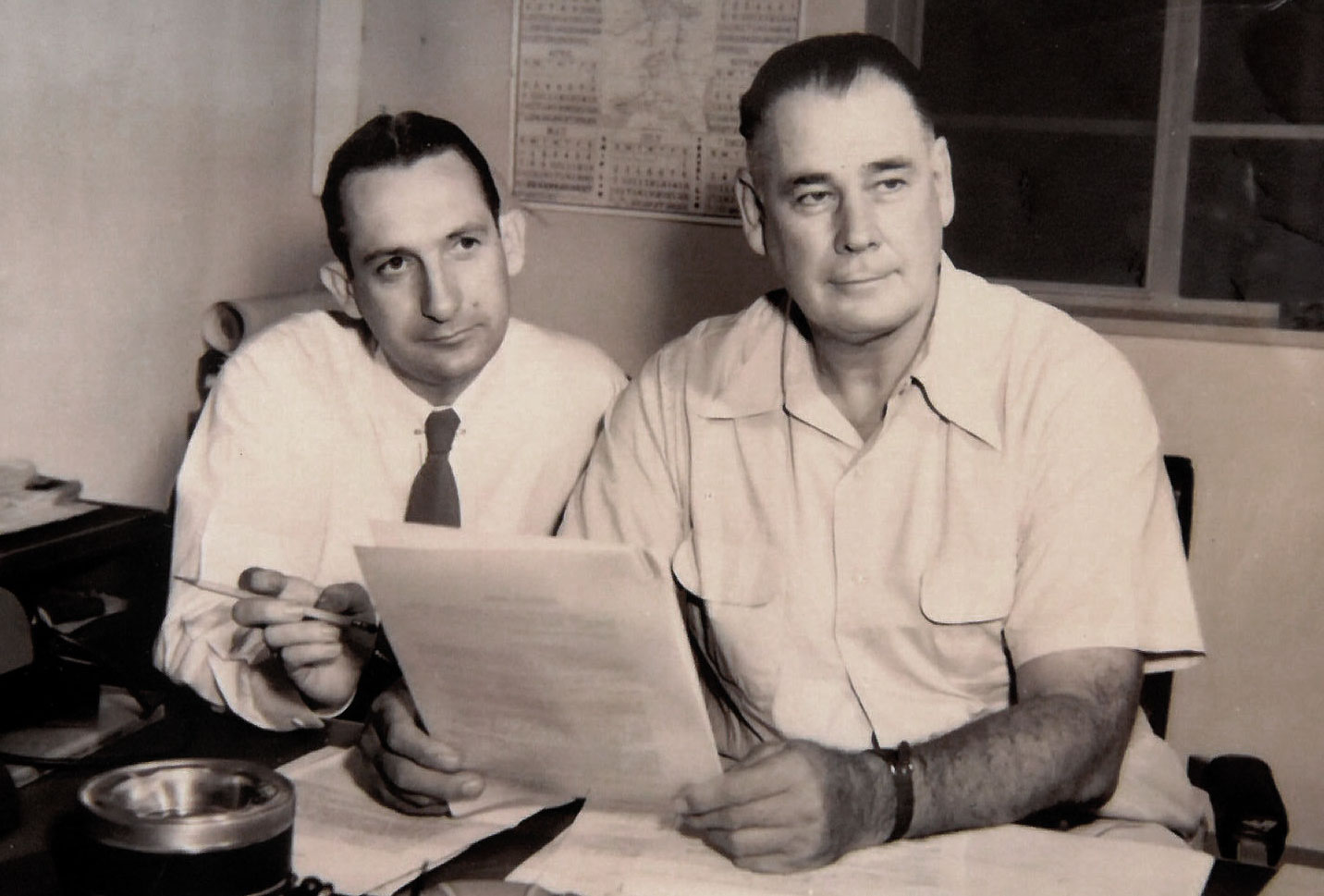
He graduated from Columbia Central High School in 1936. Though he had never been to Knoxville, he heard that tuition fees were low for in-state residents. He gathered up his earnings from stringing and umpiring, got a ride with a friend and his father to UT, and enrolled. He lived in Humes Hall, where the scholarship athletes lived, went to football practices and wrote for the Knoxville Journal and News Sentinel, at one point calling Neyland, then a major, at home to ask him about plays being run at practice. Neyland hung up and warned Nelson about the dangers of leaking strategic secrets that might aid the foes at Alabama.
Nelson was placed in an advanced English class under Roscoe E. Parker. At the end of the year, Parker offered Nelson a spot the next fall grading freshman English papers for $15 a month. That fall, an assistant coach also asked Nelson to tutor players struggling in English for the “going rate.” Nelson proposed that in lieu of pay he be allowed to live in the stadium dormitory, then under construction, and eat at the training table. The deal was done. “I was assured room and board for three years,” he wrote. In Nelson’s national broadcasting career, he found that so many Neyland players and coaches had become head coaches that “I was able to get privileged information from many of them before a major telecast. I had either graded their papers, tutored them, or met them at Tennessee.”
Nelson started filling in for the PA announcer and then helped him with PR duties, notably proofreading and correcting the grammar on press releases. Nelson got occasional gigs filling in for big-time broadcasters and made his radio debut when one of them needed a bathroom break, leaving Nelson to read the halftime statistics.
When the unbeaten Tennessee Vols played Southern Cal in the 1940 Rose Bowl, Nelson hitched a ride to California and filled in for Bill Stern, NBC’s star announcer, making a longstanding connection.
The Army and World War II
After graduation in 1941, Nelson received his ROTC commission as a second lieutenant in the 9th Infantry Division at Fort Bragg, North Carolina, where he was assigned as a public relations officer.
As it happened, Nelson was seated with friends on the Philadelphia Eagles bench at the Washington Redskins game on Sunday, December 7. Like many in the crowd, Nelson suspected that something unusual was happening when the PA announcer called for various military bigwigs to report to their stations. Only after the game did he (and most everyone else in the stadium) find out that the Japanese had bombed Pearl Harbor.
Back at Fort Bragg, Nelson heard a speech that summer from Major General George S. Patton Jr., who would lead the 9th Division in North Africa. “He was wearing cavalry boots and riding breeches,” wrote Nelson. “He carried a baton or a riding crop, whichever. And he was adorned with decorations. He told us that we were going to be terribly tough in combat. ‘We’ll…pillage their towns and run the pusillanimous sons of bitches into the sea,’ he screamed.”
Months later, entering a canvas-covered latrine in Bou Chebka, Tunisia, Nelson came face to face with the three stars on Patton’s helmet as “Old Blood ‘n’ Guts” sat on a wooden “throne.” Unsure of the protocol of such a situation, Nelson neither saluted nor said anything as he eased his way into the latrine, accomplished his mission, then eased out again. “When I had passed, on an irresistible impulse, I turned and tipped my helmet in a bit of farewell. Once outside, I ran like hell. I did not want to be in the neighborhood when he finally emerged.”
The 9th Division went on to fight in Sicily, where Nelson met Ernie Pyle, the most famous of all war correspondents, when he pulled up in a jeep with “the GI’s General” Omar Bradley. Nelson and Pyle became friends. They talked again in England as the 9th Division prepared for D-Day and kept in touch as the unit fought across France and into Germany.
Near Nordhausen, Germany, Nelson beheld a Nazi slave labor camp, “A sight that is even now almost indescribable,” he wrote. “There were those great mass graves, some still open with bodies scarcely more than racks of bones piled on top of each other. Wandering aimlessly around were some survivors, skeletal, with hollow eyes and shaven heads, and those striped pajama-like clothes. War will acquaint one with death but not this. It was man’s ultimate inhumanity to man, the complete desecration of the human being, the robbery of all dignity. That awful scene burned itself so deeply into my consciousness that I have never ever been able to completely rid myself of it.”
On the Elbe River, 50 miles from Berlin, Nelson was part of a small envoy that met and celebrated with Russian officers, drinking vodka and singing the Mills Brothers’ hit Paper Doll by a campfire, before the two allied armies formally linked up in the final months of the war in Europe.
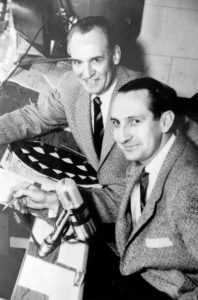
Red Grange (above) and Lindsey Nelson
With seven battle campaign stars and a Bronze Star, Captain Nelson was released from active duty in October 1945.
He returned to Knoxville to watch the Vols play Villanova, then made his way home to Columbia and “settled in to a great state of inertia.” Like so many returning soldiers, he wrote that he was not able “to wash away my continuing awareness of the experiences I had had in the war. I knew that I never really got over it.”
A Broadcast Career Begins
Soon after, he married Mickie Lambert, moved to Knoxville, and started broadcasting high school football, minor league baseball, basketball, boxing, and midget car races on WKGN radio. In July of 1948, they had a daughter, Sharon. They were stunned when they learned that she had what is now called Down syndrome. Doctors said she would not live long, but Nelson and Mickie never gave up on her, finding special schools and programs where she thrived. “She has taught her parents more about tolerance and compassion than they had ever known or ever would have known,” he wrote. “She has been and is a joy.”
Having taken over the football play-by-play on radio in 1948 and set up the Vol Network, Nelson was also doing basketball games when Neyland hired him to be UT’s sports information director in 1951, stating out loud that he knew Nelson would not be there long. Indeed, within the year, Nelson took a job with Liberty Broadcasting Network in Dallas announcing college football and professional baseball, which led in short order to an offer from NBC Sports in New York City.
In January 1954, Nelson began a five-year partnership covering college football games with Red Grange, the most exciting football hero of the 1920s, who Nelson found to be a man of boundless humility and knowledge about the game of football.
That spring, when Nelson was working for NBC in Rockefeller Plaza, Mickie gave birth to their second daughter. “We thought that Nancy Nelson would be a nice alliterative name.” They added Lynne as a hint at Lindsey. “This was before the custom of using Lindsey as a girl’s name had become popular,” wrote Nelson. The birth was noted in Ed Sullivan’s column in the New York Daily News. “I mused that when I was born in the Brownlow Creek community of Giles County, Tennessee, I had hardly received such notice. I don’t think the rural postman knew it for a few months.”
Nelson and Mickey liked to travel during the winter months between seasons. On one trip to Europe in 1956 they fell in love with the island of Mallorca off the coast of Spain near Barcelona.
“By the late 1950s,” wrote Nelson, “things seemed to be rolling for me as a television sports announcer. I was doing the game of the week in football, in baseball, and in basketball, and I was doing most of the big golf tournaments.” He also did tennis and heavyweight boxing.
The Amazin’ Mets
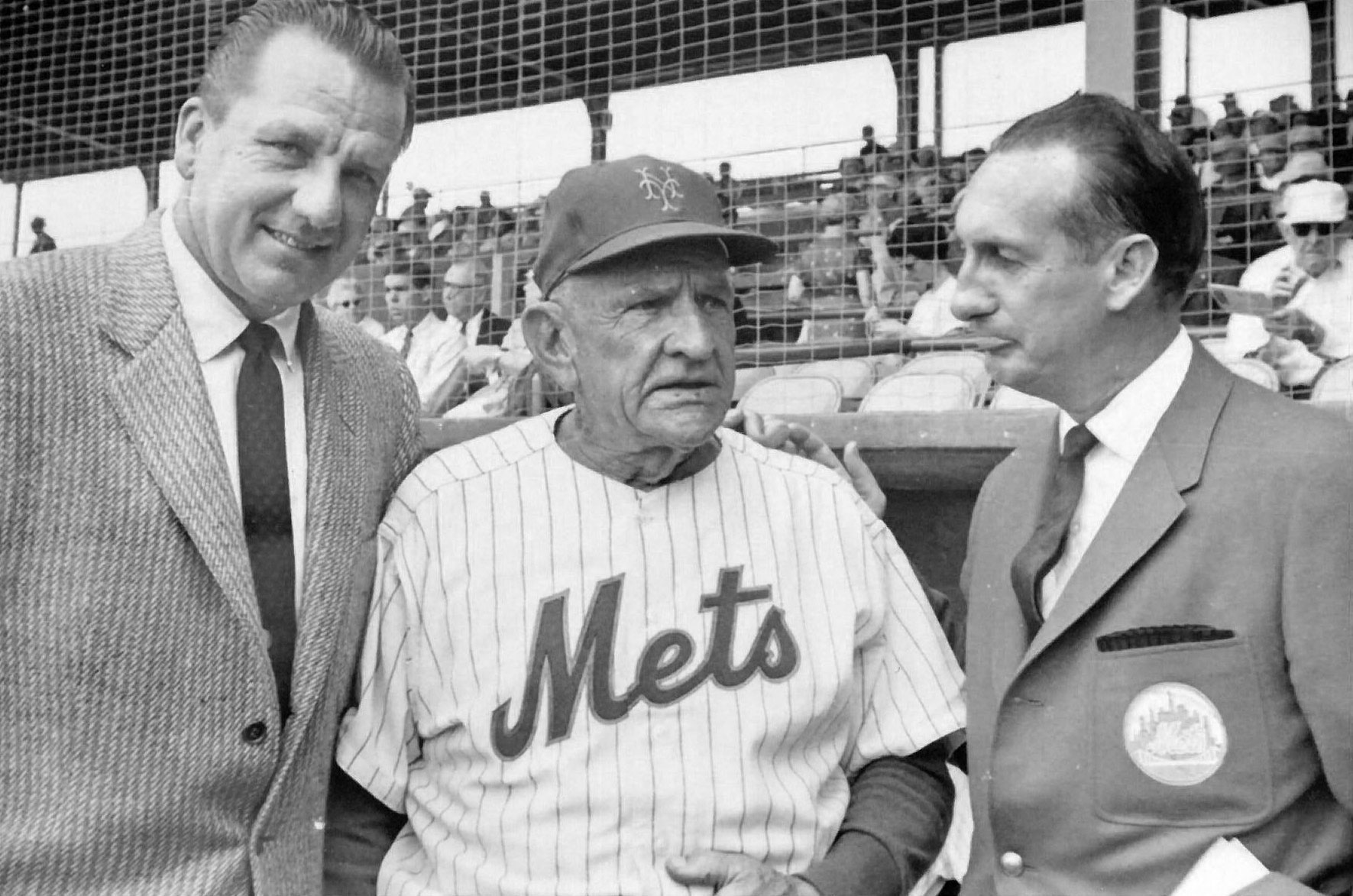
On New Year’s day of 1962, Nelson learned that he would be the lead broadcaster for the expansion New York Metropolitans, created to fill the National League void left when the Giants and Dodgers moved to the West Coast in 1958.
Nelson bought a house in Huntington, Long Island, and season box seats behind the Mets dugout at Shea Stadium for his family so he could see them while he worked. The hapless Mets lost 120 games the first season, the most of any major league team in the 20th century, prompting manager Casey Stengel to ask, “Can’t anybody here play this game?” Even as the Mets lost more than 100 games in each of the next three seasons, they won the hearts of New York fans and drew great crowds, including the Nelson family.
“I kept a box at Mets games for 18 years,” wrote Nelson. “It was the best investment I ever made. At breakfast we talked about baseball. At dinner we talked about baseball. It was the common interest of our family. Sharon developed an understanding of the game and loved it. Her favorite player was Ed Kranepool. She wrote down on her scorecard the numbers of the players in proper batting order as they were flashed up on the big scoreboard. She always had a pencil, and she kept score.” Her method was to place a neat zero after the player after each plate appearance. Nelson asked her what this meant. She answered, “It means that he has been here and gone.”
Sharon attended the Crystal Run Summer Camp in upstate New York for four summers. “She loved it and blossomed,” says sister Nancy Wyzynsky. “She was 4’11” with beautiful blue eyes and a great spirit.” Nelson told many loving stories about Sharon. One was about a plane trip. “They always flew first class,” says Wyzynsky. The man in front of Sharon kept reclining almost into her Rocquefort dressing and spilling her soda. “If he does that again, I’m going to belt him,” she said. “Please, Sharon, don’t belt him,” counseled Nelson. The man in front of them was Muhammad Ali.
In 1967, Nelson began 13 years of broadcasting Notre Dame football games. This, he wrote, gave him his “most widespread and continuing identification in the television business.” In this and many years of CBS broadcasts, his partner in the booth was Notre Dame and Green Bay Packer hero Paul Hornung—who, Vols fans will grumblingly remember, beat out Johnny Majors for the 1956 Heisman Trophy despite playing for a 2–8 team.
In 1969, the Mets miraculously rose from the cellar to win the World Series. Afterward, Nelson and Mickie decided to buy their winter refuge. Finding Mallorca too expensive, they opted for the nearby island of Menorca, where they bought a small villa near the writer Irving Wallace and enjoyed several winters in the interlude between the Cotton Bowl and spring practice. Tragically, while on their vacation in 1973, Mickie died at 52 of a cerebral hemorrhage.
Nelson flew to Sharon’s school to tell her the news. He wrote that he said to Sharon, “Your mother has died and gone to heaven.” Sharon asked, “And she’s not coming back?” “No,” Nelson replied, “You and I are going to meet Nancy in Tennessee for the funeral. And then there will be you, and Nancy, and me—and we will take care of each other.” Sharon repeated those words, “We will take care of each other.” “And that was all she said,” wrote Nelson. “Our lives would never be the same again.” When Sharon was 40, she moved to the Orange Grove Center in Chattanooga, where she lived to 62.
Nancy was a broadcasting major and cheerleader at UT, where in 1973 she was the first female Smokey mascot. Her costume, which she re-sewed herself with orange foam fur and bric-a-brac eyeballs, still resides in Hodges Library.
Nelson left the Mets in 1978 and moved into his Knoxville condo in January 1979. Having always wanted to live in San Francisco, he signed a three-year contract to broadcast for the Giants, which put him closer to Nancy, who was getting her master’s degree in broadcasting at Southern Cal.
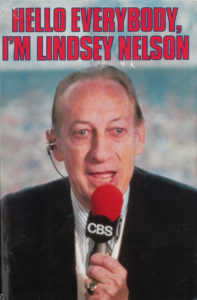
The famed broadcaster’s autobiography
After his term with the Giants, Nelson spent more time in Knoxville, where he never missed a UT baseball game and got more involved with the College of Communications, leading to teaching his broadcasting course in 1981 and ’82. “He was great,” says UT Senior Video Production Specialist Brad Prosise (’82). “He always came in with the wildest jackets.”
In 1991, UT began the process of building a new baseball stadium. At a groundbreaking ceremony on June 18, 1992, it was announced that it would be named for Nelson. Wearing a colorful patchwork jacket, Nelson quoted from the movie Field of Dreams: “If you build it, they will come. You are building it, and that you have put my name on it is an outrageous premise to begin with, but I am delighted with the idea. I can tell you that I will come. My thanks to all concerned.”
The stadium was dedicated on April 24, 1993. Nelson died of complications from Parkinson’s Disease on June 10, 1995. He is buried in Columbia, Tennessee.
Nelson’s impact is felt at UT to this day through the Lindsey Nelson Scholarship Endowment, which was established in 1989 from contributions made over the course of years from many people wishing to honor Nelson. Each year it provides a scholarship to a rising junior or senior broadcasting student in the College of Communication and Information.
For 30 years the Concord-Farragut Sertoma Club has hosted the Lindsey Nelson Memorial Benefit Golf Tournament, with proceeds going to Friends of Tennessee’s Babies with Special Needs and the Orange Grove Center, where Sharon Nelson lived for 22 years.

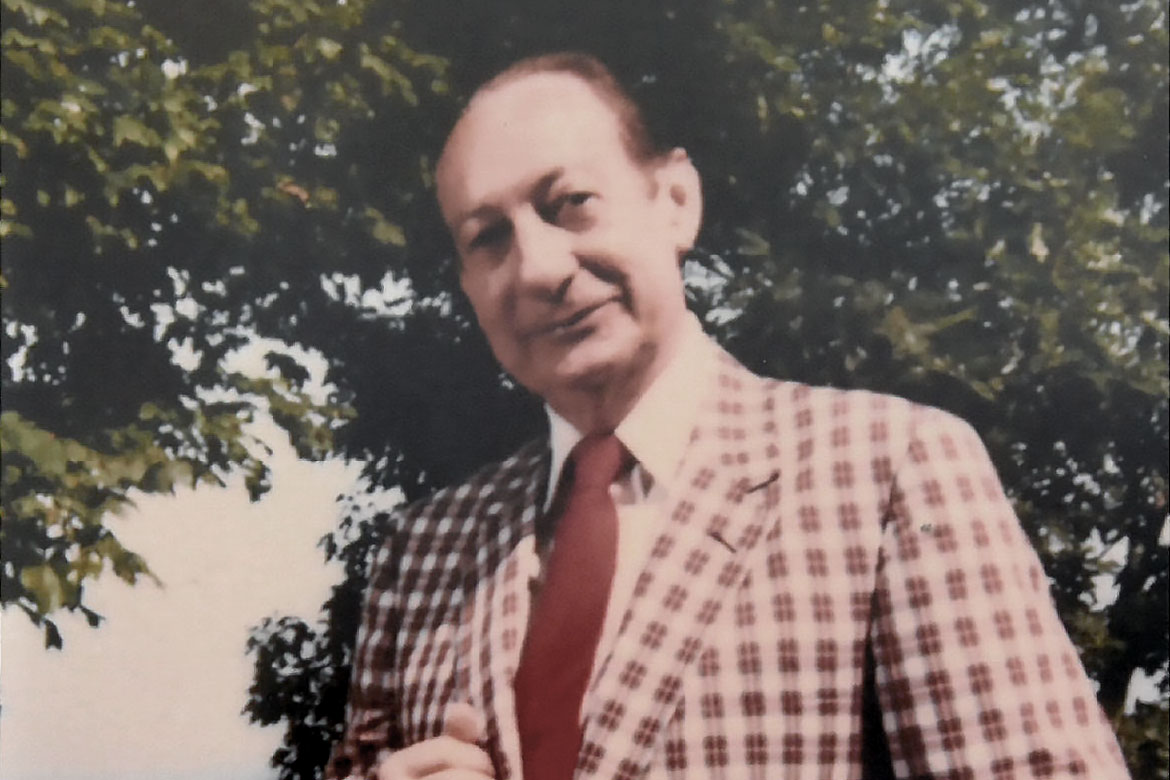

9 comments
Nelson’s daughter was at one time planning to give Nelson’s papers to the University of Tennessee. Has that happened? She told me that the papers included some letters to Nelson from Ernie Pyle. I’m working on a book of Pyle’s letters and would like to get copies of those letters. (I’m a Pyle specialist who taught in the School of Journalism at Indiana University, which for a half century was located in Ernie Pyle Hall.
Brooks Clark. This is a great article! Thanks so much for the effort you put forth.
He and Rafael Nadal have a connection. Amazing.
Thanks so much! Thank you for your help!
Awesome article. I was fortunate to have been in the first class he taught. We would stay long after class and talk about Jerry Grote and Cleon Jones and the Cotton bowl and The General. There are many stories he told I’ll never forget. Thanks!
Great story. He was a huge reason I went to UT and became a sportscaster. And when I was lucky enough to make it into the business I adopted his “Hello again everybody” at least in part to pay homage to Lindsey Nelson. Fred Cowgill WLKY (CBS/Louisville, KY)
There will never be another Lindsey Nelson
Thanks for a great article. I, too, was born in Giles County and always held Lindsey Nelson in high regard. I also came to UT married and settled in Knoxville. The Tennessee Theatre was showing classic movies and my wife and I ran into Lindsey many nights. I cherish those conversations about mutual experiences growing up in Giles and Maury Counties and about sports history. Lindsey Nelson is an icon.
Not sure how I happened upon this article, but such a great one. Lindsey and Bob Murphy and the great Ralph Kiner, back in the 1960’s, were a huge reason for my brothers and myself becoming big baseball and Met fans. Loved Lindsey’s jackets and recognizable voice, as well as his synchronicity with Bob and Ralph. And then, of course, later his broadcasting of The Cotton Bowl and even Notre Dame football games. What a pro Lindsey was. Thanks for all the great memories, Lindsey!!
Comments are closed.